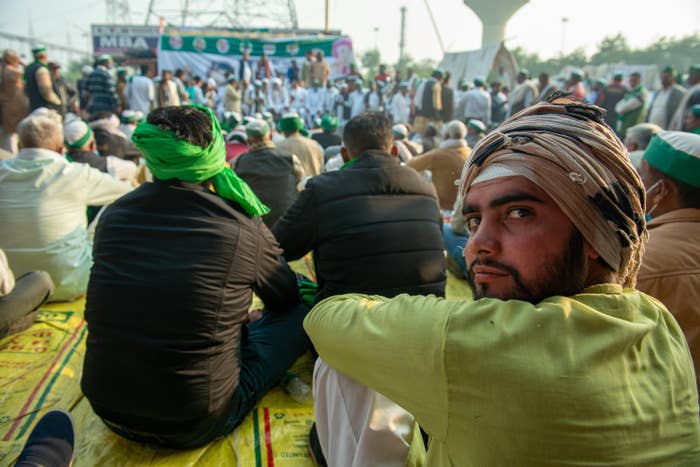
Amit Malviya was fact-checked over a misleading video of police violence in Delhi.
On Wednesday, Twitter put a “manipulated media” label on a video that the head of India’s ruling Bharatiya Janata Party’s social media department tweeted. Labeling tweets isn’t new — since March, Twitter has been putting them on inaccurate tweets from US politicians, including President Donald Trump.
But it was the first time that the company labeled a tweet from a prominent Indian politician, signaling that it may finally be ready to do what critics have been asking American social media platforms to do for years — apply the same standards to the rest of the world as they do to the US.
Possibly the first instance of Twitter applying these labels to a tweet by a member of India’s ruling party.
The three-second clip was tweeted by Amit Malviya, who is notorious for posting misinformation as part of his party’s propaganda machine. It shows a member of the police in Delhi swinging a baton at a farmer, one of the thousands of people braving tear gas, water cannons, and police barricades to protest new agricultural policies in India.
The police officer in the clip misses. According to the video’s caption, the “police didn’t even touch the farmer.” Malviya’s tweet left the false impression that police had not injured the man.
But other members of the police attacked the man just after the video clip cut off. Fact-checking websites said a longer version of the video shows a second police officer swinging at the farmer, who later showed his injuries to the press.
Twitter also applied the label to other instances of the same video tweeted by other people.
Malviya did not respond to a request for comment from BuzzFeed News, but a Twitter spokesperson said he had run afoul of the company’s policies against doctored media.
“The referenced tweet was labeled based on our Synthetic and Manipulated Media policy,” a Twitter spokesperson told BuzzFeed News. Clicking on the label leads people to a Twitter-authored summary of debunks by fact-checkers and links to those debunks.
The policy, which Twitter announced in February, defines “synthetic and manipulated media” as pictures or videos that have been “significantly altered or created in a way that changes the original meaning/purpose, or makes it seem like certain events took place that didn’t actually happen.” The company first applied the label in March to a deceptively edited video of now-president-elect Joe Biden shared by White House social media director Dan Scavino and retweeted by the US president, and has since applied it to multiple tweets by Trump.
But even though the Twitter spokesperson said the policy was being “enforced around the world,” the company declined to cite other instances of that label being applied to accounts in non-Western markets. (In the past, Twitter has deleted or hidden tweets by Brazilian President Jair Bolsonaro and Brazilian politician Osmar Terra for breaking its policy against coronavirus misinformation.)
Digital rights activists have long said that American tech companies haven’t done enough to prevent harm caused by their platforms outside the US and Europe. Platforms like Facebook, WhatsApp, Twitter, and YouTube have been accused of not only polarizing political discourse, but also fueling ethnic massacres in South Sudan, lynchings in India, and genocide in Myanmar.
“When it comes to labeling misinformation and manipulated content, companies are starting to take more action, but they still need to do better outside the United States,” said Dia Kayyali, associate director of advocacy at Mnemonic, a human rights organization. “We saw them pour huge resources into the US and action more content than anyone could have imagined. Unfortunately, until now, they haven’t devoted as many resources outside of the US.”
In India, experts say that Twitter was forced to label Malviya’s tweet after being consistently called out by the press, fact-checkers, and people on social media. “It’s the result of sustained criticism of years,” Pratik Sinha, the editor of Alt News, an Indian fact-checking website, told BuzzFeed News. But, he said, “this is a first step. It’s too early to be happy.”
It's also too early to see what results the label could have. Labeling a tweet from a prominent member of India’s ruling party could invite backlash in a country Twitter considers a key growth market.
Politicians from the BJP have accused Twitter of having “bias” against conservatives. Last year, Colin Cromwell, Twitter’s vice president of global public policy, published a blog post titled “Setting the record straight on Twitter India and impartiality.” Three days later, an Indian parliamentary committee grilled the company’s Indian executives about the company's alleged bias.
The label is also significant because the video that Malviya tweeted was a response to a tweet by Rahul Gandhi, an opposition leader belonging to the Indian National Congress, the country’s oldest political party and a BJP rival — meaning that Twitter is saying that one party’s facts are wrong.
Twitter declined to provide details about why it decided to label Malviya’s tweet in particular. “In order to determine if media have been significantly and deceptively altered or fabricated, we may use our own technology or receive reports through partnerships with third parties,” a Twitter spokesperson said.
“BJP members,” said Kayyali, “can’t say whatever they want just because they are politicians.”
